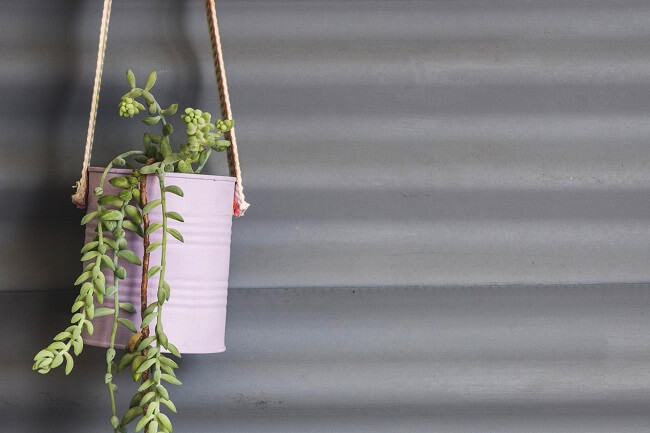Our Top 10 Picks For The Best Indoor Hanging Plants
Table of Contents
If you’re looking to upgrade your indoor plant game, it may be time to consider adding hanging plants to your repertoire. Indoor hanging plants are a great way to add even more greenery to your home, and are an elegant addition to practically any space. We here at CraftSide have put together a list of our top ten best indoor hanging plants to help you choose the right plant for you. Keep reading to learn a little bit about each plant and get a short overview of its general care and growing requirements.
Arrowhead Plant (Syngonium podophyllum)
The Arrowhead Plant is a very common houseplant, and has been for quite some time. It’s a very popular choice for apartment-dwellers, and for good reason – this plant is very tolerant of less-than-ideal low light conditions that would surely kill weaker plants. It’s a perfect choice for those poorly-lit corners of the home, as it thrives even in low light conditions. Be careful not to expose it to direct sunlight, however, as it could burn the plant’s delicate leaves. It’s native to the rainforests of Latin America, ranging from Mexico to Bolivia, where it grows upwards from the jungle floor by climbing on the trunks and roots of trees. Keep the soil of your Arrowhead Plant consistently moist (but not soggy), and plant in rich potting mix. House in a well-draining planter, and mist frequently to imitate the plant’s natural humid environment. This plant prefers temperatures around 80 degrees, but will tolerate temperatures as low as 60 degrees.
English Ivy (Hedera helix)
Although it is an invasive species in the Americas, and oftentimes seen as a nuisance when found outdoors, the English Ivy makes for a beautiful indoor hanging plant. It’s native to Europe and Western Asia, and was introduced to the New World by European colonists in the 1700s. As an indoor plant, English Ivy requires bright indirect sunlight, and should be planted in nutritious and rich soil high in organic matter. Fertilize once-monthly in the summer months when the plant is actively growing, and water only once the top two inches of soil have dried. It prefers cool temperatures ranging between 50 degrees to 65 degrees, and should be rinsed off periodically to remove accumulated dust.
Heartleaf Philodendron (Philodendron hederaceum)
This beautiful trailing plant, with its heart-shaped glossy leaves, has been an indoor houseplant favorite for a quite some time. It is native to Central America and the Caribbean, and is a climbing plant in its natural habitat, and is a popular houseplant worldwide because of how easy it is to keep alive. The Heartleaf Philodendron needs bright indirect light, although it will also do well in low light conditions. Keep away from direct sunlight, and maintain consistently moist soil during the growing season that lasts from spring through fall. In winter, let the top layer of soil dry between waterings. The Heartleaf Philodendron prefers temperatures no lower than 60 degrees, and will adapt well to most indoor humidity conditions.
Spider Plant (Chlorophytum comosum)
The Spider Plant is a hardy plant native to Africa. It is commonly sold as a hanging plant, but can be a tabletop plant as well. It’s a very tough plant, and is a great choice for novice plant owners as it is notoriously difficult to kill. It prefers a spot with consistent indirect sunlight throughout the year, but will do well in medium and low light conditions as well. Pot in well-draining soil, and keep in an area with a temperature ranging between 55 to 65 degrees. Water when the soil dries, and err on the side of dry if you are unsure – these plants have structures called rhizomes which allow them to store water and enable them go several weeks between waterings with no ill effects.
Golden Pothos (Epipremnum aureum)
Another staple house plant, the Golden Pothos is one of the classics. It can be found in offices and homes worldwide, and has become naturalized in many regions, but it originates from the small island of Mo’orea in French Polynesia. The Golden Pothos prefers bright indirect light, but will adapt to almost any lighting conditions you throw at it, including very low light. It is also a great plant if you have a hard time keeping up with a regular watering schedule, since it prefers its soil to be completely dry between waterings and won’t mind a bit of neglect. It’s comfortable at standard indoor temperatures ranging from 60 to 75 degrees, but can tolerate temperatures as low as 50 degrees.
String of Pearls (Senecio rowleyanus)
Originating from dry regions in southwestern Africa, the String of Pearls is a type of plant known as a succulent. The characteristic “pearls” of this plant are an adaptation that help it store water in its dry natural environment, and enable it to go long periods of time between waterings. The String of Pearls does best in partial sun and plenty of indirect sunlight, and should be potted in well-draining soil. Water approximately every 14 days or when the top layer of soil is dry. In winter, water no more than once a month. They prefer an indoor temperature of around 70 to 80 degrees in the summer, and no lower than 55 degrees in the winter.
String of Hearts (Ceropegia woodii)
A tough yet elegant trailing plant, the String of Hearts is native to southern Africa. It is another plant on our list that is a downright challenge to kill, even for novice plant owners. It enjoys bright indirect sunlight, but will do well in partial sunlight also. Water at on a regular schedule and only once the top two inches of soil are dry to the touch. Keep in a hanging planter in a warm corner in the home, as this plant prefers temperatures that hover around 85 degrees. In winter, however, it can tolerate temperatures as low as 60 degrees.
Burro’s Tail (Sedum morganianum)
The second succulent on our list, the Burro’s Tail (also known as Donkey’s Tail) is a unique-looking trailing plant native to Southern Mexico and Honduras. As a succulent, it requires infrequent watering, and its soil should be allowed to dry out almost completely between waterings. When watering, soak the soil completely and allow any excess water to drain. The Burro’s Tail enjoys bright indirect light or partial sun, and could burn if it gets too much direct sunlight. It prefers temperatures around 70 degrees, but will tolerate temperatures as low as 40 degrees for short periods.
Inchplant (Tradescantia zebrina)
Hailing from the rainforests and wetlands of Central America, the Inchplant, sometimes known by the common name Wandering Jew, features striped leaves in a deep shade of purple. In its natural habitat (or when planted outdoors), the Inchplant is a crawling plant, growing fast to climb walls and cover ground. Indoors, it is often kept in hanging planters, where it sends its tendrils downward and hangs elegantly from its planter. This plant requires bright but indirect light in order to maintain its beautiful markings, and should be regularly pinched back to encourage full and bushy growth. Keep the soil consistently moist, and water when the top inch of soil has dried. It prefers temperatures ranging from 50-80 degrees, and should be misted regularly to imitate its natural high-humidity environment.
Prayer Plant (Maranta leuconeura)
The Prayer Plant is native to South and Central America, where it grows in tropical rainforests. It prefers bright indirect sunlight, and should not be placed in direct sunlight as it may burn. Maintain consistently moist soil during the summer months when the plant is growing, and feed regularly to support new growth. In winter, allow the top layer of soil to dry before watering again. The Prayer Plant is so named because its leaves fold closed each night, as if they were two hands coming together in prayer. It prefers temperatures around 70 degrees, and should be regularly misted to ensure that it receives sufficient humidity. Fertilize twice a month in the summer, when the plant is growing, and once a month in the winter when the plant is dormant.

